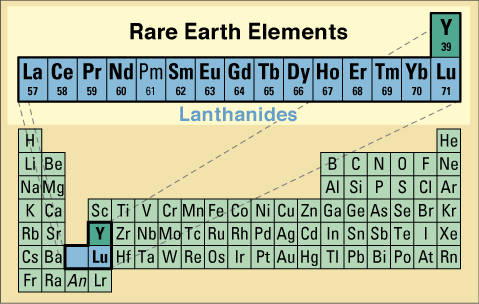Rare earth elements are used for nuclear batteries, lasers, magnets, portable x-ray machines and aerospace components. But they are also used for your everyday items: laptops, cars, smartphones, TVs, LCD displays, light bulbs, optical networks, and cameras.
China produces over 97% of the world’s rare earth supply and has announced plans to reduce its export quota to 35,000 tons per year in 2010–2015, ostensibly to conserve scarce resources and protect the environment.
Rare earths — a block of seventeen elements in the middle of the Periodic Table (pictured below) — are not rare, but are very hard to obtain commercially. Generally, rare earth elements are only found in minute quantities in mineral deposits of clay, sand, and rock (earths!), which must then be processed to extract the rare metals — an expensive process, and also costly for the environment as billions of tons of ore must be mined and refined to yield just a few tons of usable rare earths.
Recycling electronic waste is an option to get back the throw-away elements or using technology that does not require these elements, like graphene. The end all, after they have depleted and ravaged China’s supply, is to find another source. We must quench the unsatiable thirst for our gadgets.
The United States Geological Survey is actively surveying southern Afghanistan for rare earth deposits under the protection of United States military forces. Since 2009 the USGS has conducted remote sensing surveys as well as fieldwork to verify Soviet claims that volcanic rocks containing rare earth metals exist in Helmand province near the village of Khanneshin. The USGS study team has located a sizable area of rocks in the center of an extinct volcano containing light rare earth elements including cerium and neodymium. It has mapped 1.3 million metric tons of desirable rock, or about 10 years of supply at current demand levels. The Pentagon has estimated its value at about $7.4 billion.
Rare earth elements are not exchange-traded in the same way that precious (for instance, gold and silver) or non-ferrous metals (such as nickel, tin, copper, and aluminum) are. Instead they are sold on the private market, which makes their prices difficult to monitor and track.
Read more: Wiki, Rare Elements via U.S. Geological Survey, ExtremeTech

No comments:
Post a Comment